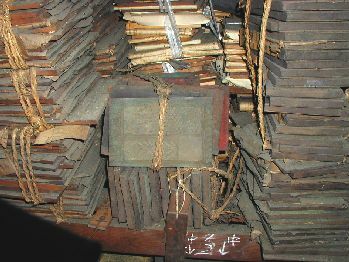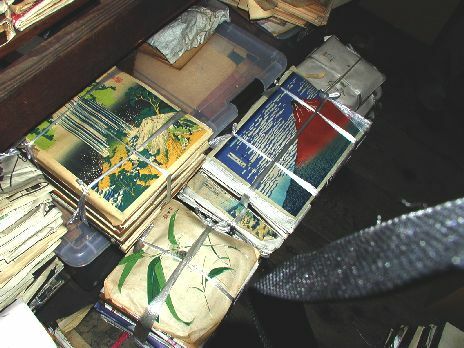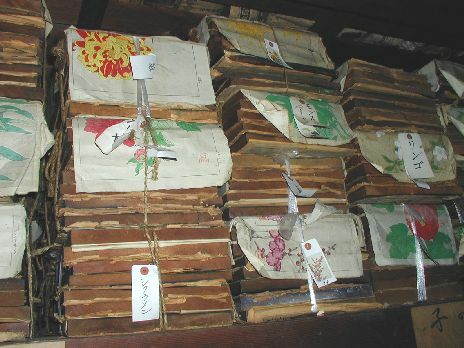Unsodo - A Talk with the President
Regarding the fine shin-hanga woodblock prints by Unsodo Publisher, many of their seals and some artists' information is already
accessible
here at this website. Now however (March 2002), for the very first time, I had the opportunity to meet with
Mr. Teiichi Yamada, President of Unsodo in Kyoto.
Unsodo is a publishing house of long tradition. Founded in 1891 (Meiji 24)
- not in 1887
as mentioned in Merritt & Yamada by Naosaburo Yamada - it is still a family enterprise and run
by the third generation by Teiichi Yamada, the grandson of the founder. This
tradition most likely is to continue, because the son of the present President,
young Mr. Yamada, is also himself active in the family business.
|
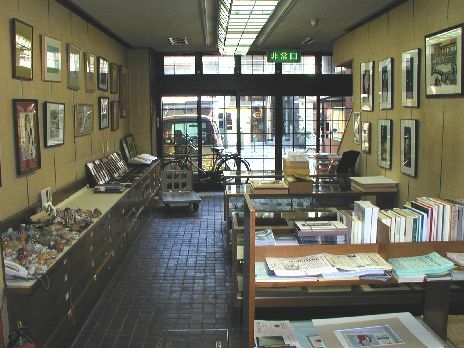
|
|
|
A view inside the Unsodo Shop in Teramachi
/ Kyoto
|
Unsodo of Kyoto is located in the traditional, beautiful Teramachi District
in Kyoto, not far from the Nijo Palace. In a small street, which suddenly opens
into a wide space in front of the shop, we see already from the distance the
black Unsodo signboard with its characteristic "kanji" lettering. The store itself is spacy, with
many prints handsomely displayed upon its walls. Many more prints are visible within the glass vitrins. Shoppers, and
the woodblock print collectors among them, can easily spend many hours here. Upstairs is a another small
gallery where still more prints are displayed, amoung them a range of flower prints, that
have found entry into a catalogue of the famous French fashion house Hermes. Also on
display is a set of brushes and "baren," shown to demonstrate the basic
tools of the woodblock printing process.
An old signboard of the store has survived the
War and is also on display. Unusual for us - at least in Japan - is the writing in the typical French "Art Noveau"
style--where East meets West and West meets East. The three digit telephone
number "290," mentioned again in Japanese writing in the bottom line from right to
left, tells us how old this signboard really is. And note, Unsodo sees themselves curiously as being
"booksellers!"
|

|
A small office is at the end of the showroom, where several employees take
care of the daily business, which nowadays is concentrating still more on books and
their decorations than on the selling of woodblock prints.
But the true treasure certainly is certainly not just the inventory of prints within the shop, but rather, lays hidden
in the darkness of a separate building nearby. Adjacent to the Unsodo shop and not visible from the
street, is a typical Japanese "kura," a stone-built warehouse, with
small iron clad windows only in the second floor. Such "kura" (fire-safe storage rooms) date at least to as early as Edo era Japan (pre-1868), when Japan's cities were frequently ravaged by fires--and so, shopowners and homeowners typically used them to store their valuables. Here, secured by a massive steel door, this
building is the storage for many thousands of woodblocks - books, ukiyoe, flower
prints and shin-hanga!!
|
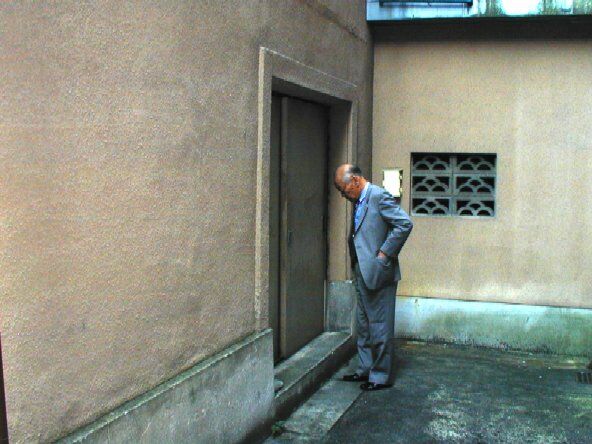
|
Mr. Yamada was incredibly gracious to grant me access to this specially guarded building. Surprised by
the darkness - the wooden blocks almost turned into deep black after many decades
of storage - and impressed by the sheer amount of woodblocks, I moved between the heavy shelves
laden with hundreds and hundreds of these carved blocks.
The traditional construction of the "kura," combined
with the heavy volumn of woodblocks, keeps both temperature
and humidity almost constant throughout the year - a must for
woodblocks which would otherwise warp and change in their dimensions.
To the right: Mr. Yamada amidst of his "treasures".
|
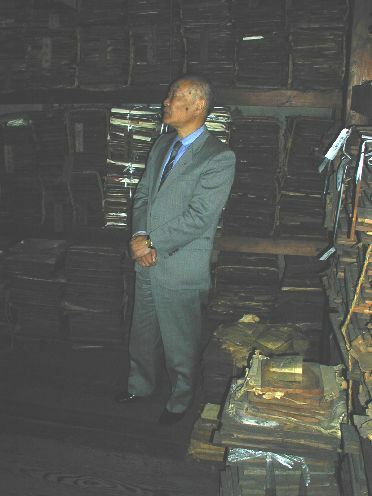
|
Most of the blocks were kept together as a complete "sets," often wrapped
into newspapers (the date of the newspaper easily indicates when the last reprinting
had occured) and bound together. On top of many such bundled sets is often seen the particular
print image put there for their immediate identification; other block sets are simply identified
by a lable, see here in the right image, "ringo = apple", or Cyclamen, both in Japanese
characters.
Several blocks observed were carved on both sides to save material, and the remaining pigments also made it clear
that occasionally two different pigments got applied onto the same block - provided
there was some physical distance between the designs cut.
To keep track of such an impressively large inventory, which was accumulated over a period that
covers more than a whole century, is certainly a challenging task. Right now, it is my
feeling that the people involved simply remember where a specific set of blocks
rests in the storage.
Found among the blocks also rests the entire original blocks of the Hokusai "Manga,"
which got reprinted as a complete 15-volume set by Shinmi Saburo on behalf
of Unsodo in 1961.
The primary interest of my visit was, of course, to learn more about the shin-hanga artists
Kasamatsu Shiro (1898 -1991) and Asano Takeji (1900 - 1999). Of the former, Kasamatsu himself had 102 prints published by
Unsodo over an eight-year period spanning from 1952 to 1960, before Kasamatsu himself then turned completely
to
the "sosaku" philosophy of carving, printing and publishing prints completely
through himself, influenced by the early death of his second son (aged 20) in
1955. The collaboration of Unsodo with Asano, about whose scope of works
less is known so far, began in 1949 and continued for a couple of years.
Somewhat surprisingly, Unsodo's stock of prints of both these artists is now rather limited, clearly an
indication of past good sales. The sought-after first editions of high quality are now
virtually all gone. One should also keep in mind that in addition to sales done by Kyoto Unsodo, a lot of additional business
is done via Unsodo's Tokyo branch. From both artists, Unsodo published only works
in the tradional "oban" format--they did not publish any "chuban"
size (half sheet) prints or postcards. The primary printer was Shinmi Saburo (sometimes incorrectly
pronounced "Niimi," because the kanji of his name allows both possibilities).
Shinmi, born 1912 in Shizuoka Prefecture, learned printing around 1930 from
his uncle Yohei Shinmi and remained active until around 1996.
|
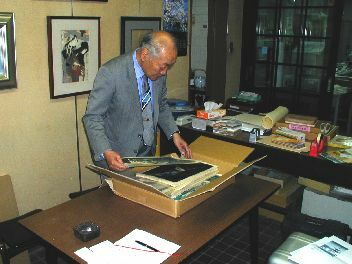
|
Then forwards (since approximately 1996), a young new printer named Toda now acts for Unsodo for the reprints of Kasamatsu
and Asano. Note however, it cannot be excluded that some prints although made by Toda, still (incorrectly) show
the
"koma" bearing Shinmi's name (as printer) within the prints' left margin. One of the first later editions to correctly show Toda's
printer's seal
is Kasamatsu's famous design of the "Nikko Kegon Falls." This new edition of 50
sheets is printed on paper with a high "mica" content, adding a nice shine to
the print's surface.
Of course, it is known that the EARLIEST versions of the prints of both Kasamatsu and Asano bear a "key-block" printed date in
Japanese writing within their lower left margins, whereas later editions do not. At this point Mr. Yamada revealed an amazing discovery--he
explained that immediately upon completition of each prints' very first edition (which comprised
usually 100 sheets) the "key-block's" carved date then got cut from the block. Hence, ALL later reprints--although
to a great extend still printed during the lifetime of the artists--are therefore undated. The significance of this revelation is that such dated "first edition" prints are much more scarce than previously believed.
|
Additionally, it is also observed that occasionally "first editions" and "later editions" show
even further differences than simply the "date-block" of the first version.
For example, here we see in the leftside image a first version of Kasamatsu's "Spring
at the Moat," while to the rightside is a later edition. Apart from
the different color scheme of the background wall and the wave
pattern - the early version tends to be warmer - and a different
"bokashi", we notice, that the printer added in the
later (right) version a red forehead into the reflection of the middle
swan, which does not exist in the early version. Also, the "seals"
are different. Compare the large artist's "seal" in the lower right
image corner of the first edition with the "standard"
Kasamatsu "seal/signature" combination in the right upper image
corner of the late edition.
|

|
Another discovery--according to Mr. Yamada my small catalogue raisonnee of Kasamatsu's works (titled "Shiro Kasamatsu--The Complete Woodblock Prints") which
mentions all his prints published by Unsodo, probably even includes one print too many: the print #U-90,
"Moonlight over the Inland Sea," 1958, bears a seal "Shintaro". Although
this print is listed by Unsodo itself as #SK-31 in their official Kasamatsu Catalogue, Mr. Yamada
believes that the artist is actually Shintaro Okazaki and that they for reasons
of convenience - since only one print of this artist was in question and the style
and character fit very well into the Kasamatsu prints - they simply treated this
print as "a Kasamatsu."
|
This author, however, knows of at least one other print
(carved by Okura, printed by Shinmi) published by Unsodo which bears
the red boxed “Shintaro” artist’s seal. This nicely done view of a pagoda in snowy weather is, however, in its entire composition
and workmanship substantially different from #U-90--therefore, both images
do not seem to come from the same artist as their “handwriting” is
too different. Certainly more research is required to come
up with a conclusion whether #U-90 really may be attributed to Shintaro
Okazaki and not to Shiro Kasamatsu.
|
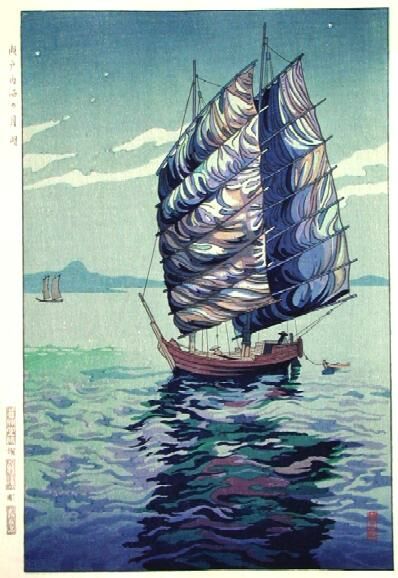
|
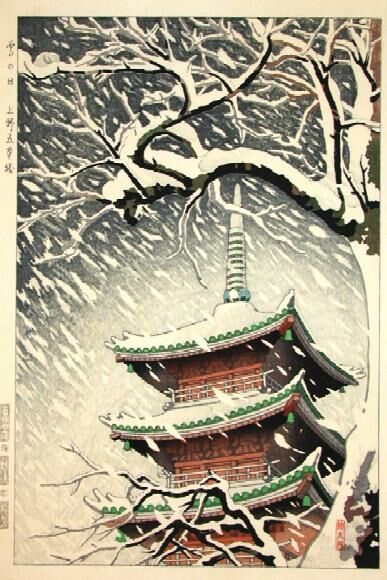
|
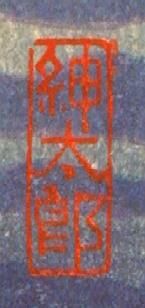
|
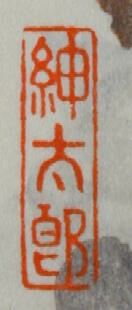
|
|
|
#U-90, "Moonlight over the Inland Sea"
|
( "Yuki no Hi - Ueno goju no to")
"Snowy Day - Five-story Pagoda at Ueno"
|
"Shintaro"
|
"Shintaro"
|
As an aside--another print, "Ikebana" (#U-102), which had not previously been precisely dated in the "Complete Kasamatsu" book has just recently been discovered in a margin-dated state. By reading its "kanji" date ("Showa niju nana nen saku"), we now know with certainly that "Ikebana" was created in 1952 and not merely "around 1960" as Unsodo of Tokyo had surmised when asked about this print several years ago.
The prints #U-42 and #U-43 ("Naruko Hot Springs," 1954) are according to an exhibition at the Yamanashi Prefecturial
Museum in 1996 as being two different versions - a light and a dark one. However, Mr. Yamada cannot remember that
different versions were done on purpose--rather, he guesses that most probably two color variants (caused by different batches of the print) were mistakenly taken to be different versions.
All in all, the meeting with Mr. Yamada was both very pleasant
and most
interesting--but, of course, too short. Certainly there will be a follow
up!!
To the right: The author with Mr. Yamada inside the
Kyoto Unsodo shop.
|
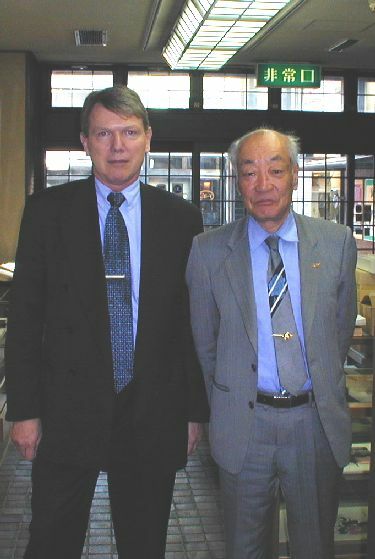
|
© Copyright Dr. Andreas Grund (with editing by Thomas Crossland) 2002




